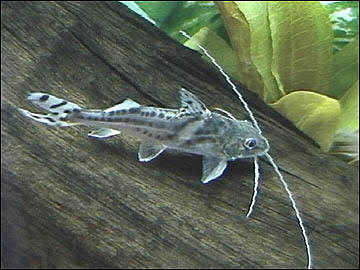Catfish - Pictus
Polka Dot Pictus, Polka Dot Catfish, Spotted Pimelodus Scientific Name: Pimelodus pictus
Fri, 4th July, 2025 - 6:57 am GMT
Sponsor Ads:

Alternative Name
Polka Dot Pictus, Polka Dot Catfish, Spotted Pimelodus Scientific Name: Pimelodus pictusBasic Info
The Pictus Catfish has an elongated body, which is a shiny silver-white color. Several black oval-shaped spots will be present on the body as well. The Pictus Catfish has a large adipose fin with a black tip. Their other fins will have black marks as well. These fish have long barbels that help them scavenge for food and navigate in dark water. The Pictus Catfish has sharp serrated pectoral and dorsal fins, which are poisonous. These fins can inflict painful cuts, if not handled carefully. The averaged sized Pictus Catfish seen in the pet trade is between three and six inches, though their maximum size is up to 2 feet and this should be kept in mind before purchase. They can live to be roughly eight years of age.
Health
Like most other Catfish, the Pictus Catfish is a hardy species. It needs a water temperature from 72 to 78 degrees fahrenheit, and a pH level from 5.8 to 7.2. The fish is a predator, and should be fed live foods, like blood worms, glass worms, brine shrimp, tubifex worms, fish, crustaceans, and invertebrates. It will eat frozen, freeze dried, and tablet foods as well. They should be fed often. When trying to capture these fish, a glass container should be used in place of a net, because their fins will most likely get caught in the net, causing complications. Breeding Pictus Catfish do not breed in captivity, and the two sexes are indistinguishable.Habitat
Fresh water fishBehavior
The Pictus Catfish, also known as the Polka Dot Pictus or Polka Dot Catfish, is one of the prettier Catfish available. Its relative small size, overall hardiness, and patterned body make it a good fish for both beginning and experienced aquarists alike. The Pictus Catfish is a peaceful fish. If kept in groups, they will most likely form schools, even with fish outside of their own species. Since the Pictus Catfish is a nocturnal animal they are mostly active at night, so many people may not observe this behavior. Many Pictus Catfish will hide during the day, especially if they are kept in well-lit tanks, only coming out to eat or when the lights go down. As they grow older, Pictus Catfish can become territorial, if kept in groups. However, they will not harm each other, but will make noises that can be heard well outside the tank. Also, if not well fed, the Pictus Catfish will eat smaller fish, such as the Neon Tetra. Pictus Catfish should be kept in medium sized tanks with plenty of hiding spaces, and with a moderate amount of live plants and driftwood.Origin
ColumbiaHistory
N/ACommon Foods
N/ASponsor Ads:
Under the most rigorously controlled conditions of temperature, pressure, humidity, time, and voltage, the machine will do as it damned well pleases. -- Unknown
Catfish - Pictus
Coded by: BGID® | ALL RIGHTS RESERVED Copyright © 2000-2025
Disclaimer | Privacy | Report Errors / Contact | Credits

 Preparing For China. China is growing their military. China Military Technology - can it keep up with the US?
Preparing For China. China is growing their military. China Military Technology - can it keep up with the US?  versus
versus 

 versus
versus 
 This Thread is about the North Korean Military itself - the kind of army, navy, and air force they have.
This Thread is about the North Korean Military itself - the kind of army, navy, and air force they have. 
 versus
versus 
 versus
versus  versus
versus